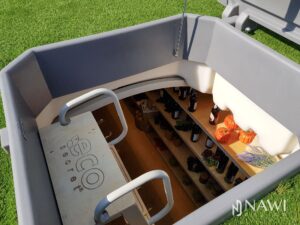
How to Lower the Temperature in Your Basement?
The basement serves various purposes, from storing food to housing wine collections and tools. However, during the summer, it can become a place where temperatures rise to undesirable levels, posing a threat to stored goods and items. Therefore, it’s essential to know how to effectively lower the temperature in your basement. In this article, we will discuss several effective ways to make your basement more comfortable and suitable for storing various items.
- Thermal Insulation:
Thermal insulation is crucial for maintaining a stable temperature in the basement. Ensure that the walls, ceiling, and floor are well insulated. This involves using appropriate insulation materials such as mineral wool, polyurethane foam, or styrofoam. Well-done insulation will help trap heat in the winter and keep the space cool in the summer.
- Ventilation:
Ventilation is another critical aspect of temperature control in the basement. Install fans to facilitate air circulation. You can also open basement windows and doors at night or in the early morning when the outside temperature is lower than inside. This will allow cool air to enter and expel warm air.
- Air Conditioning:
If the basement is a place where you store valuable items like wine, consider installing an air conditioning system. An air conditioner can provide precise control of temperature and humidity in the basement, regardless of external conditions.
- Sun Protection:
Installing blinds or curtains on basement windows can help block sunlight. Sunlight can significantly raise the temperature in the basement, so shading windows can significantly aid in maintaining a cooler indoor climate.
- Utilize Passive Cooling:
Passive cooling is a technique that relies on natural processes to lower the temperature in the basement. You can place bowls of water or ice in the room to help cool the air. Additionally, using stones or ceramic tiles that cool down at night and release heat during the day can be an effective way to maintain a cooler environment.
- Limit Heat Sources:
If there are electrical appliances in the basement, such as a refrigerator, washing machine, or dryer, ensure they are well-ventilated and, if possible, separated from the rest of the space. These appliances generate heat during operation and can significantly impact the temperature in the basement.
- Regular Maintenance:
Don’t forget to perform regular maintenance on cooling, ventilation, and insulation systems in the basement. Identifying and fixing any damages or leaks can help maintain the desired temperature conditions.
In summary, lowering the temperature in your basement can be a challenge, but with the right measures and techniques, it is achievable. This is particularly important if you store valuable items or products that require constant temperature conditions. Through thermal insulation, ventilation, air conditioning, and other means, you can create a more comfortable and suitable environment in your basement, ensuring long-term protection for the items stored there.




